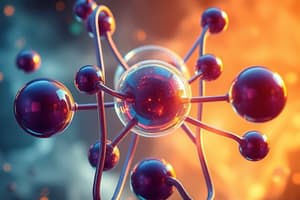Podcast
Questions and Answers
Which element is the most abundant component essential for sustaining life?
Which element is the most abundant component essential for sustaining life?
- Oxygen (correct)
- Sulfur
- Nitrogen
- Hydrogen
Nitrogen is only found in proteins and not in nucleic acids.
Nitrogen is only found in proteins and not in nucleic acids.
False (B)
What role does phosphorus play in the human body?
What role does phosphorus play in the human body?
It is important in the blood buffering system.
The _____ model depicts the structure of an atom with electrons in concentric rings.
The _____ model depicts the structure of an atom with electrons in concentric rings.
Match the trace elements with their functions:
Match the trace elements with their functions:
What is matter defined as?
What is matter defined as?
Gases have a definite shape and volume.
Gases have a definite shape and volume.
The four most common elements found in living organisms are __________, oxygen, nitrogen, and hydrogen.
The four most common elements found in living organisms are __________, oxygen, nitrogen, and hydrogen.
Name two subatomic particles found in an atom.
Name two subatomic particles found in an atom.
Match the following types of matter with their characteristics:
Match the following types of matter with their characteristics:
Flashcards are hidden until you start studying
Study Notes
Chemistry of Living Organisms
Matter
- Defined as anything with mass and volume that resists motion changes.
- Composed of tiny particles, primarily atoms.
- Atoms consist of subatomic particles: protons, neutrons, and electrons.
Atoms
- Smallest unit of an element, retaining its chemical properties (e.g., hydrogen, oxygen).
- Differentiation among atoms based on the number of protons, neutrons, and electrons.
- Matter exists in three primary states:
- Solids: Definite shape and volume (e.g., wood).
- Liquids: No definite shape, adopts the shape of the container, has volume.
- Gases: No definite shape or volume; takes the shape of the container.
Elements
- Building blocks of matter, cannot be chemically broken down.
- Approximately 109 known elements, including metals, non-metals, and metalloids.
- Four main elements in living organisms: carbon, oxygen, nitrogen, hydrogen.
- Carbon: Essential for life, makes up about 18% of human body weight.
- Oxygen: Vital for life, abundant in water.
- Hydrogen: Important for molecular structure and bonding.
- Nitrogen: Key component in proteins and nucleic acids.
- Includes sulfur (a component of proteins) and phosphorus (important for blood buffering).
Trace Elements
- Required in small amounts for bodily functions, often as parts of enzymes or hormones.
- Examples include fluoride (dental health), chromium (insulin function), and cobalt (part of vitamin B12).
Atomic Structure
- Bohr Model: Atoms have electrons arranged in concentric rings around a nucleus of protons and neutrons.
- Isotopes: Variants of elements with the same proton number but different neutron counts.
- Protons are positively charged and are used to identify elements.
Biological Molecules
Carbohydrates
- Source of energy and structure, characterized by ring structures (e.g., glucose).
Lipids
- Insoluble in water, soluble in organic solvents.
- Composed of fatty acids and glycerol.
- Classified into saturated (animal sources) and unsaturated (plant sources) fats.
- Contain 9 cal/g, providing concentrated energy and structural components in cell membranes.
Proteins
- Comprised of 20 amino acids; around 8 are essential.
- Structure determines function; proteins provide 4 cal/g.
- Function as enzymes, hormones, and structural elements (e.g., hemoglobin, myosin).
- Sources of complete proteins include animal products like eggs and meat.
Nucleic Acids
- Include DNA and RNA, made up of nucleotides (base, sugar, phosphate group).
- Essential for genetic material and Protein synthesis.
Cell Structure and Function
Cell Membrane
- Surrounds cell organelles and regulates substance movement.
- Contains proteins for communication and substance transport.
- Transport methods include active (requires ATP) and passive processes (e.g., diffusion, osmosis).
Nucleus
- Enclosed by a double-layered nuclear membrane, contains genetic material.
- Chromosomes carry DNA; nucleolus synthesizes RNA.
Mitochondria
- Energy conversion centers, involved in cellular respiration to generate ATP.
Differences Between Plant and Animal Cells
- Plant cells: Have cell walls, chloroplasts, and large central vacuoles.
- Animal cells: No cell wall, contain lysosomes and an extracellular matrix.
Transport Mechanisms
- Diffusion: Movement from high to low concentration until equilibrium is reached; reliant on kinetic energy from the environment, classified as passive transport.
- Heating can increase the rate of diffusion; cooling conversely slows it down.
Studying That Suits You
Use AI to generate personalized quizzes and flashcards to suit your learning preferences.




